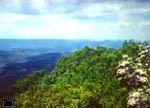
Shenandoah National Park, Virginia
Wild, Wild East
The Eastern North America looks like a naturalist's nightmare
on World population density or industrial development maps. Few people realize
that it is one of the most interesting parts of our planet not only for a fast
food addict, but also for a biologist. Even among the locals, it is a widespread
belief that the East is just one huge megalopolis with few small parks inside,
that you need to visit the West to see any wild and unspoiled
Nature. Fortunately, it's not true.

New York City, New York.
Nannorrup nelsoni, World's
smallest centipede, was recently described from a park here. |
Although vast parts of the East are now converted
to smog-wrapped cities, or paved over as freeway junctions, there is enough land
in between for some wilderness. As the plague of large-scale logging have been
exported to Canada and the Third World, the forests of the East are now recovering,
and so does the wildlife. Unfortunately, many key components of Eastern ecosystems,
such as red wolf, Pennsylvania bison, passenger pigeon, and American chestnut,
have been lost, some of them forever. |
| A common, but heart-breaking sight in the forests
are young chestnuts sprouting from old stumps. They are all doomed to be killed
by introduced chestnut blight fungus (Cryphonectria parasitica) before
reaching maturity. Chestnut used to be the dominant tree in the East, and an important
food source for many animals. Some other trees, such as American elm or white
pine, have also been wiped out in many areas by introduced diseases or logging. |

Fruits of American
Chestnut (Castanea
dentata), Michigan. |
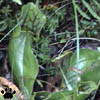
Pitcher plant
(Sarracenia),
Pine
Barrens, New Jersey. |
All these tragic events are even more sad because
they happen in one of the most precious parts of our planet. Eastern US and China
are the main areas where the diverse flora and fauna of Tertiary Period still
survive. The East has more species of salamanders, turtles, pines, and carnivorous
plants, than any other place in the World. | 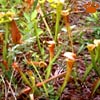
Pitcher plant
(Sarracenia),
Big Thicket, Texas. |
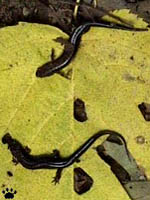
|
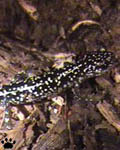
|
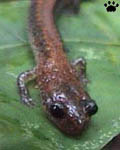 |
| Lungless salamanders,
left to right: four-toed (Hemidactylius scutatum), slimy (Plethodon
glutinosus), mountain dusky (Desmognathus ochrophaeus), red-backed
(P. cinereus). Pennsylvania. |
|
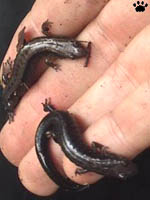
|
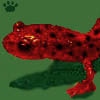
Long-tailed salamander
(Eurycea longicauda),
Manteo, N. Carolina. |
Freshwater fauna is particularly
interesting. Almost every river of the seaboard between Chesapeake Bay and Mexican
border has its own species of fish and mussels. Some of these endemics are very
beautiful, and many are endangered, but they get little attention from environmentalists,
not to mention general public. |

Dwarf waterdog
(Necturus punctatus),
Congaree, S. Carolina. |

Lesser siren (Siren intermedia),
Torreya State Park, Florida. |
This small park (right) is home to many of unusual
creatures and some endemic trees. But the only reason tourists visit it is because
it was the location of two Confederate cannons during the Civil War. |
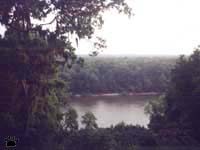
View of Appalachicola River,
Torreya State Park, Florida. |

Painted turtle (Chrysemys
picta), Mio, Michigan. |
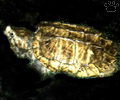
Alligator snapping turtle (M.
temmincki), Mayo, Florida. |
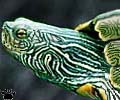
Cagle's map turtle (G.
caglei), San Marcos, Texas |

Pond slider (Ch. scripta),
Beaver Lake, Tennessee. |

Eastern box turtle
(Terrapene carolina), Onondaga Cave,
Missouri. |
Well, getting little attention is not always bad.
Turtles and tree snails, for example, get too much - some have been almost wiped
out by collectors. Turtles of the East range from tiny, bizarre and stunningly
beautiful map turtles (Graptemys), to giant snapping turtles (Macroclemys),
known to kill little children. Seeing them in the wild takes lot of patience.
You can spend hours approaching their basking logs slow enough to avoid scaring
them away. |

Eastern box turtle is the
world's largest
animal
capable of freezing
while hybernating. |
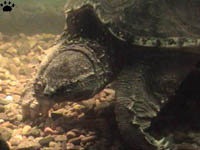
Snapping turtle (Chelydra serpentina),
Tuocuonga, Indiana.
|
Some are completely aquatic, like snapping
and softshell (Trionyx) turtles, almost never leave water and can only
seen by diving; others are more terrestrial, like wood (Clemmys insculpta)
and box turtles. |
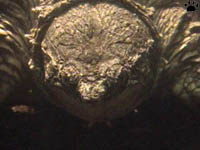
Snapping turtle (Chelydra serpentina),
Tuocuonga, Indiana. |
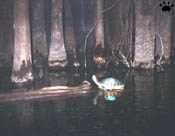
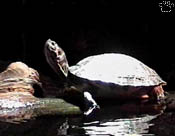
Diamondback terrapin in a cypress swamp,
Cape Hatteras, N. Carolina. |

Wood turtle, Cape Cod, Massachusets.
Diamondback terrapin (Malaclemys
terrapene) inhabits sea coasts, and seldom enters fresh water. Good places
to see many turtle species are Beaver Lake area, Tennessee, northern parts of
the Everglades, Florida, Colorado Bend, Texas, and some coastal rivers in Gulf
States, Florida Panhandle and North Carolina. |
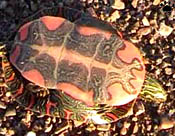
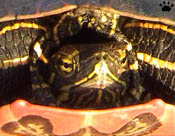
Painted turtle (Chrysemys picta),
Niobrara Valley, Nebraska. |
 |
 |
 |
 |
 |
| Minnows (Notropis cummingsae,
Cyprinella pyrhomelas, N. leuciodus, Nocomis leptocephalus, Phoxinus oreas)
from rivers of N. Carolina. |

Bluehead chub (Nocomis
leptocephalus), Dan River, Virginia. |
700 species of fishes from 40 families
can be seen by snorkeling in rivers, lakes and swamps of the East - the most diverse
non-tropical freshwater ichthyofauna. About 100 species are already extinct or
endangered, but local freshwater diving sites are still among the World's best. |

White catfish (Ameiurus catus),
Atchafalaya River, Louisiana. |
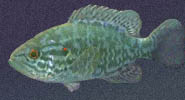 |
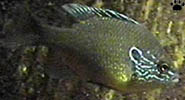 |
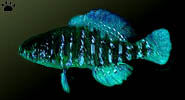 |
| Sunfishes (Lepomis
gulsus, Enneacanthus gloriosus, Elassoma evergladei) from lakes of Georgia. |

Muskellunge (Esox masquinongy),
Lake Ontario, Ontario. |
In some small rivers of the Appalachian
foothills you can see more than thirty fish species in one hour of snorkeling. |

Red shiner (Cyprinella lutrensis),
Neosho River, Kansas. |
 |
 |
 |
| Various species of darters
(Etheostoma, Percina) from rivers and lakes of the Carolinas, Tennessee,
Kentucky and Missouri. Most of these pictures are close to natural size. |
|
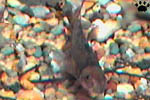 |
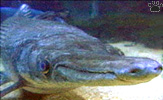
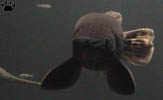
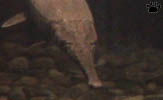
Alligator gar (Atractosteus spatula),
Mississipi River, Tennessee. |
Some of North American freshwater fishes
are "living fossils", such as gars, bowfin fish, and sturgeons. These relicts
are not neccessarily shy and humble creatures: alligator gars may exceed 3m (10')
in length.
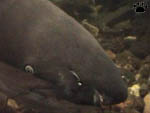
Blue catfish (Ictalurus furcatus),
Missouri River, Iowa.
These giants are now very difficult to see underwater, but huge catfishes can
still be found in many rivers and lakes of the East. |


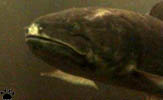
Bowfin (Amia calva),
Santee River, S. Carolina. |

Paddlefish (Polyodon spatula), Mississipi River, Tennessee. |

Longnose gar (Lepistoteus osseus), Cape Fear River, N. Carolina. |
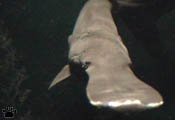
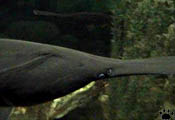
Paddlefish, Mississippi River, Tennessee. |
Upper Missouri River and slow-flowing
channels of Mississippi still contain some large fish, but finding a place with
water transparent enough for diving takes some time.

Yellow perch (Perca flavescens),
Lake Ontario.
Shovelnose (Scaphirhynchus platorynchus) and pallid (S. albus) sturgeons
are particularly difficult to see in the wild. |
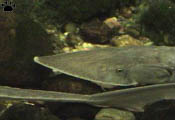

Shovelnose sturgeon, Mississippi, Iowa. |

Walleye (Stizostedion vitreum), Lake Superior, Michigan.
Part 2. The Deep South
Home
|